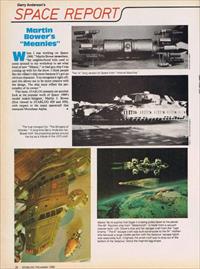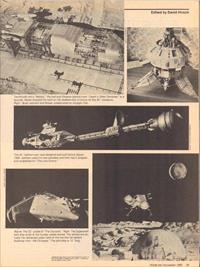Starlog
MARTIN BOWER: A Rising Star in the World of Miniatures
Starlog Number 29 (Dec 1979); "Space Report: MARTIN BOWER: A Rising Star in the World of Miniatures" by David Hirsch p32-34
Images thanks to Jerome Wybon.
Since the dawn of motion pictures, when the first science-fiction story was captured on film, special-effects men have been called upon to create what exists only in the imagination. Like their counterparts of yesteryear, the cinema magicians of today require the use of model builders to construct spacecraft, alien landscapes and other forms of fantasy.
With the quality of today's technology, the model builder has become a master craftsman. The featureless towers in Flash Gordon have been replaced with the finely detailed miniatures, such as the city in Logan's Run. The smooth skinned spacecraft of the 1950s have been replaced with the complex, weird and wonderful galactic designs seen in such productions as Space: 1999, Star Wars and Alien.
In 1974, British producer Gerry Anderson was involved in the production of the first 24 episodes of Space: 1999. He received a letter and a package of photographs from a young model builder named Martin Bower. Impressed by the quality of his work, Anderson replied, setting up a meeting between Martin and Space: 1999's special-effects director, Brian Johnson.
"Brian liked my work and gave me my first real break for which I shall always be grateful," Bower recalls. "He sent me a script from the episode 'Alpha Child" and asked to see what I could come up with."
A few days later, Bower returned to Bray Studios with his interpretation of the alien spacecraft that would bring the fugitive aliens to Moonbase Alpha. Johnson approved the design and gave him the go-ahead to produce two versions of the craft - one 30 inches long and another five feet in length.
For the alien battlecrusier that appears in the finale of "Alpha Child", Johnson purchased a six-foot, eight-inch model Bower had built some years earlier that was heavily influenced by the craft in 2001. This same craft appears in the episode "War Games" and was later redressed for "The Last Enemy." "We often redressed models for other episodes, simply because there wasn't enough time to build a new one," Bower relates.
As a result of his success with that initial assignment, Bower was hired to continue to build models for the series. It had been the answer to his life-long dream. "I love the idea of making the imaginable a reality through films and SFX. I used to go see any film with models in it and sit through the film more than once at a time."
Bower attributes his love for models and model making to his childhood exposure to Supercar, Fireball XL5 and many of the other Gerry Anderson SF puppet shows of the 1960s. His drive for fine detail in his work may be the result of his admiration of Stanley Kubrick. "I love his films and I just don't mean the obvious - 2001. The standards he's set in his pictures are very high. The soundtrack, the photography, everything's just perfect, and I admire what it is in a man that can keep him turning out that kind of film and put the same enthusiasm into all the different subjects he's covered."
Bower has also been a fan of stop-motion photography ever since he saw Ray Harryhausen's First Men In The Moon.
"I learned my craft the hard way - by trial and error. When I was a boy, I was always the odd one out in regards to my hobby, as many of my friends considered models as toys. They thought it was childish." Despite such peer-group pressure, Bower's love for model building prevailed and he spent the next few years of his life struggling to develop his modelling techniques.
After finishing school, he landed a job with a company that manufactured display models. His three-year association there gave him a chance to develop welding and lathe capabilities, techniques which would become vital to his work in film a few years later.
With this continual exposure to model fabrication, Bower was able to discover what were the best materials to utilize. "This, of course, depends totally on the shape of the model and how many versions of that model you have to build. For instance, if a model has flat sides and no curves, I would use plexiglass, since this is strong and is a great base to stick to. The gun tank built for Space: 1999 episode 'Taybor' is a classic example. If the shape is curved, however, or has rounded corners, then it is carved in wood. Jelutong, the pattern-maker's wood, is used for this. The nose cones of the Swift, Superswift (both Space craft) and Altares (built for Day After Tomorrow) were solid wood. Now, if more than one model is required, then you start making glass fiber molds. Other than that, brass is used for girder work; it is strong and easily soldered together. Sometimes a model will be a combination of all these techniques. It all depends on the shape.
"I suppose the two greatest expenses in model building are the cost of the large amounts of paint required and, of course, the number of hours you must put in. Plexiglass, metal and wood can often be purchased cheaply as scrap and off-cuts from big companies.
"Pieces from plastic hobby kits can be used for dressing along with many old radio components, especially the insides of old valves. I often try to get away from using too many kit bits because so much is being done with them."
Some of the models Bower built for Space: 1999 were as small as three inches long (suspended-animation coffins for "The Exiles") and as large as 12 feet (the Daria for "Mission of the Darians"). Depending on the materials involved in their construction, these models weigh anywhere from a few ounces to 30 pounds.
Bower was called upon to use his creative skill on no less than 50 different models of all shapes and sizes for the 48-episode TV series. "Many of the models" he recalls, "were of my own design. The Eagle was Brian Johnson's. Of course, that was before I came along. I worked alone on many of them, but I'd discuss ideas with Brian. He gave me sketches of some ideas he had and I would interpret them. The Hawk was part his and part mine, as was Voyager One, Gwent and the S.S. Daria.
"When designing, I don't really refer to any reference material for basic ideas and shapes beyond the descriptions in the script. I try not to do the same thing twice myself, and, as far as possible, steer away from being influenced. It's easy to be influenced unintentionally. Many times I've thought I had an original design and someone says it looks like this or that. I do have definite ideas of what I want a thing to look like, often from my first idea for a model. I once looked at a photo fo a fly's eye and used that as a reference on the construction of the ship for 'The Dorcons.' The domes on the side resembled such eyes."
During the break between the filming of the first and second seasons of Space: 1999, Bower continued to design and build models to keep in practice. Many of these models, created solely for his own pleasure, were eventually purchased by Brian Johnson for use on the second season of Space. At the same time, Bower was also asked to build eight models for Anderson's TV special The Day After Tomorrow (Into Infinity). (See STARLOG #26). It was during this production that Bower designed and built what he feels is his most challenging model to date, the photon-powered spacecraft Altares. "It took ages to build, and it nearly finished me off. I sliced a chunk out of my hand while cutting the metal tube inside."
The Altares wasn't the only challenge Bower had to face in his new professional career. On Space:1999, he found that "trying to get models ready, designing, building and delivering them, often all in 10 days, was really the challenge. Thinking up new ideas gets more and more difficult. The pressure was really on all through season one and it didn't ease up on season two."
After completing Space:1999, Bower moved on to work on the BBC-TV series Doctor Who, Blake's 7 and Mrs. Noah, and he acted as both designer and model builder on the Thames Television series The Tomorrow People. Brian Johnson again put Martin's work on film for the theatrical features The Medusa Touch and Alien. He also did the model work on Gerry Anderson's commercial for Jif Dessert Topping, called Alien Attack.
Bower is currently devoting all his time to creating models for Dino De Laurentiis' Flash Gordon. However, he admits that model building isn't all he would like to do in films. "Well, I'd love to more landscapes and sculpture work. I do a lot of the latter at home in plasticine, usually figures and creatures. I'd love to do more of this for films. I used to build landscapes to photograph my models in and it's great building up rock formations in plaster and getting in a real state. It makes a nice change form the intricate work I normally do. I would also love to direct special effects on a film of a science-fiction nature and see my ideas come to life."
And what is Martin Bowers advice to others who yearn to be model builders? "Just keep practising - which if you're keen you'll do anyway - but if you intend to take up model making professionally, learn other skills related to modelling, like metal work and carpentry. These will prove to be invaluable later on. Many times I've had young lads say, 'I'm a model maker," and you ask them what they've done and they show you an Airfix kit they've made. There's nothing wrong with the kit, mind you, but, really, there is a lot more to it than that."
Starlog 40 (Nov 1980)

